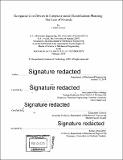| dc.contributor.advisor | Jose Ignacio Pérez-Arriaga. | en_US |
| dc.contributor.author | Drouin, Cailinn | en_US |
| dc.contributor.other | Massachusetts Institute of Technology. Department of Mechanical Engineering. | en_US |
| dc.coverage.spatial | f-rw--- | en_US |
| dc.date.accessioned | 2018-05-23T16:28:57Z | |
| dc.date.available | 2018-05-23T16:28:57Z | |
| dc.date.copyright | 2018 | en_US |
| dc.date.issued | 2018 | en_US |
| dc.identifier.uri | http://hdl.handle.net/1721.1/115656 | |
| dc.description | Thesis: S.M., Massachusetts Institute of Technology, Department of Mechanical Engineering, 2018. | en_US |
| dc.description | Cataloged from PDF version of thesis. | en_US |
| dc.description | Includes bibliographical references (pages 76-79). | en_US |
| dc.description.abstract | This body of work builds upon that of others in the Universal Access Lab at the Massachusetts Institute of Technology who have endeavored to contribute to the resolution of a complex set of global issues by exploring possible solutions to the challenges of achieving universal energy access. To this end, a technoeconomic electricity infrastructure modeling software referred to as the Reference Electrification Model, or REM, has been conceived as a tool of potential use in navigating those particular obstacles which lie at the nexus of technology and policy. This thesis explores the incorporation of topography-related cost driver information into the least-cost technology selection, network design, and costing processes of REM. The objective of this initiative is to incorporate geospatial information in such a way as to accurately reflect the challenges associated with construction, operation, and maintenance of electrical infrastructure in the presence of such geographical features as mountains, waterbodies, and wetland areas, as well as human-designated areas which may be considered sensitive to development, as in the case of national parks and wildlife reserves. This thesis also endeavors to provide a critique of REM in its current capacity through the lens of past electrification planning efforts in the country of Rwanda in order to formulate recommendations regarding both the use and further development of this planning tool. | en_US |
| dc.description.statementofresponsibility | by Cailinn Drouin. | en_US |
| dc.format.extent | 106 pages | en_US |
| dc.language.iso | eng | en_US |
| dc.publisher | Massachusetts Institute of Technology | en_US |
| dc.rights | MIT theses are protected by copyright. They may be viewed, downloaded, or printed from this source but further reproduction or distribution in any format is prohibited without written permission. | en_US |
| dc.rights.uri | http://dspace.mit.edu/handle/1721.1/7582 | en_US |
| dc.subject | Mechanical Engineering. | en_US |
| dc.title | Geospatial cost drivers in computer-aided electrification planning : the case of Rwanda | en_US |
| dc.type | Thesis | en_US |
| dc.description.degree | S.M. | en_US |
| dc.contributor.department | Massachusetts Institute of Technology. Department of Mechanical Engineering | |
| dc.identifier.oclc | 1036985369 | en_US |
